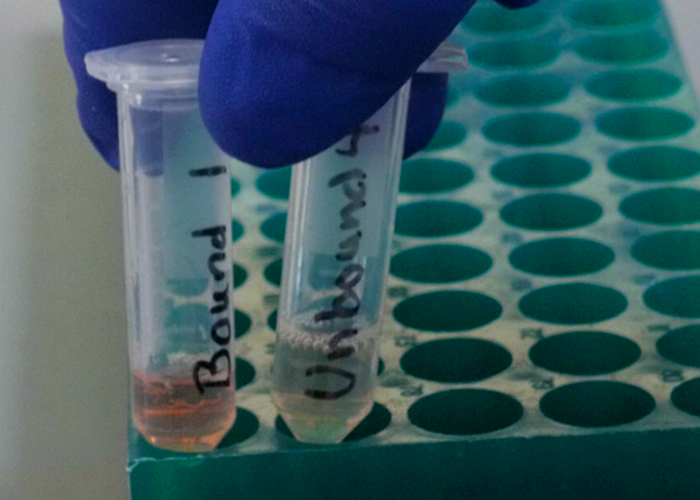离子交换色谱法
Overview
资料来源: 实验室的博士 B.吉尔 Venton-弗吉尼亚大学
离子交换色谱法是色谱的分离基于电荷分析物类型。列用那充满了带电的固定相,坚实的支持,被称为一种离子交换树脂。强阳离子交换色谱法优先分离出来阳离子通过使用-带负电荷的树脂,而强阴离子交换色谱法优先选择阴离子通过使用一种带正电的树脂。这种类型是色谱的受欢迎的样品制备,例如在蛋白质或核酸样品的清理工作。
离子交换色谱法是一个两步过程。第一步,样品装上加载缓冲区中的列。绑定到列树脂带电样品的基于树脂吸引样品相反电荷的离子相互作用。因此,带电的样品的相反极性树脂到强烈绑定。其他分子,不收取或相反的电荷是不受约束和通过列洗。第二步是洗脱绑定到树脂的分析物。这被通过盐的梯度,在缓冲区中盐的用量现在慢慢地上升。馏分收集在列的结尾作为洗脱发生和纯化的样品感兴趣的可以恢复这些组分之一。另一种技术,如谱,可能需要确定哪一部分包含示例。离子交换色谱法是在蛋白质研究,隔离有特定电荷或大小,感兴趣的蛋白质,如大小可以确定在与树脂之间的交互中尤其有用。
离子交换色谱法是更一般的分离技术比亲和层析,也常用于蛋白质样品制备抗体相连列绑定一个具体分析物。必须为每种分析物,购买新的亲和柱,而同一类型的离子交换柱,经常与不同的洗脱条件,可以用来清理许多蛋白质相同罪名。离子交换色谱法也可以与其他类型的色谱分离基于其他属性一起使用。例如,尺寸排阻色谱法分离基于大小和可以在离子交换色谱法之前用来选择只给定大小的化合物。
Procedure
1.准备样品和列
- 在这个演示中,一种 2 蛋白混合物将阳离子交换柱上分离: 血红蛋白和细胞色素 C.添加 0.2 毫升平衡缓冲 (pH 8.1) 蛋白样品和涡拌匀。2 分钟要删除任何泡沫的离心机。
- 阳离子交换柱置于试管 5 分钟,使树脂来解决。夹紧测试管柱上环站,以确保它是直立。
- 打开顶盖的列,然后底部的上限。滴出来进试管的重力作用下的列中允许的缓冲区。
- 洗两次列列-卷 (在这种情况下,列卷是 0.3 毫升) 的平衡缓冲区。添加第二个列卷之前的平衡缓冲滴出入废瓶让第一列卷 (0.3 毫升)。这一步让平衡与平衡缓冲区的列。在这一步,不打扰树脂慢慢添加平衡缓冲区。
2.运行蛋白样品通过阳离子交换柱
- 将列放在标记为"未绑定 1"2 毫升离心管中。仔细地加载 0.1 毫升到该列顶部的蛋白样品。
- 一旦样品已加载到列的顶部,用冲洗 0.3 毫升的平衡缓冲区在列的顶部添加缓冲区并允许它滴,一路过关斩将。重复此步骤 4 x (共 5 洗) 并收集每个洗在单独
Application and Summary
Tags
跳至...
此集合中的视频:

Now Playing
离子交换色谱法
Analytical Chemistry
264.6K Views

分析制备的样品制备
Analytical Chemistry
84.8K Views

内部标准
Analytical Chemistry
204.8K Views

标准加入的方法
Analytical Chemistry
320.2K Views

校准曲线
Analytical Chemistry
797.0K Views

(紫外-可见) 的紫外-可见光谱法
Analytical Chemistry
623.7K Views

拉曼光谱化学分析
Analytical Chemistry
51.2K Views

X 射线荧光光谱 (XRF)
Analytical Chemistry
25.4K Views

气相色谱 (GC) 与火焰电离检测
Analytical Chemistry
282.1K Views

高性能液相色谱法 (HPLC)
Analytical Chemistry
384.6K Views

毛细管电泳 (CE)
Analytical Chemistry
94.0K Views

质谱分析法导论
Analytical Chemistry
112.3K Views

扫描电子显微镜 (SEM)
Analytical Chemistry
87.2K Views

负载型催化剂,用恒电位仪/结合电化学测量
Analytical Chemistry
51.4K Views

循环伏安法 (CV)
Analytical Chemistry
125.3K Views
版权所属 © 2025 MyJoVE 公司版权所有,本公司不涉及任何医疗业务和医疗服务。
